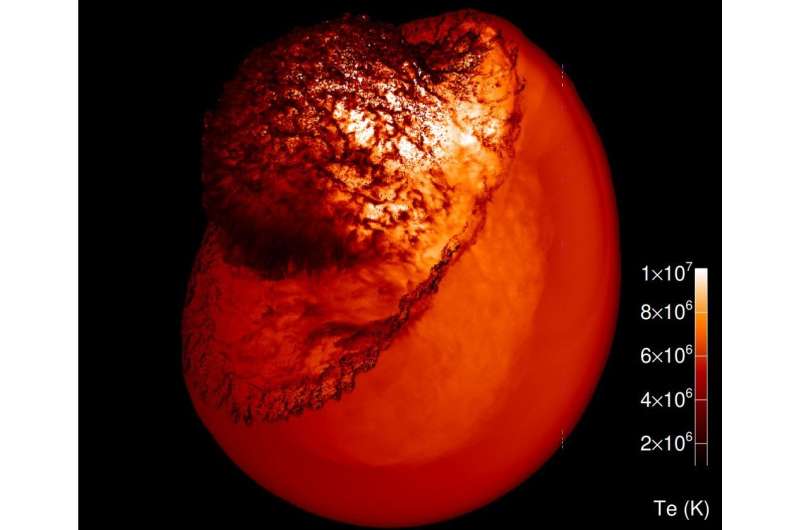December 22, 2020 report
Study sheds more light on the complex morphology of supernova remnant IC 443

Italian astronomers have developed a 3-D model for the supernova remnant (SNR) IC 443 in order to investigate the morphology of this source. The model allowed the researchers to gain more insights into the complex morphology of SNR IC 443 and provided crucial information about X-ray emission from this object. The study was detailed in a paper published December 15 on arXiv.org.
SNRs are diffuse, expanding structures resulting from a supernova explosion. They contain ejected material expanding from the explosion and other interstellar material that has been swept up by the passage of the shockwave from the exploded star.
Studies of supernova remnants are important for astronomers as they play a key role in the evolution of galaxies, dispersing the heavy elements made in the supernova explosion into the interstellar medium (ISM) and providing the energy needed for heating up the ISM. SNRs are also believed to be responsible for the acceleration of galactic cosmic rays.
IC 443 mixed-morphology SNR (MMSNR) with a diameter of about 50 arcminutes and belongs to the GEM OB1 association at a distance of approximately 4,900 light years. The SNR exhibits a shell-like morphology in the radio band and centrally filled thermal X-ray emission.
Observations show that IC 443 appears to consist of two interconnected quasi-spherical subshells of different radii and centroids. It also turns out to have a quite complex environment as it interacts with a molecular cloud in the northwestern and southeastern areas and with an atomic cloud in the northeast.
Recently, a team of astronomers led by Sabina Ustamujic of the INAF-Palermo Astronomical Observatory, Italy, has developed a three-dimensional hydrodynamic (HD) model for IC 443, which describes the expansion of the SNR and its interaction with the surrounding circumstellar/interstellar medium (CSM/ISM). The model allowed the scientists to investigate the origin of the complex morphology and multi-thermal X-ray emission observed in this SNR.
"We modeled the expansion of the SNR and its interaction with the surrounding environment, parametrized in agreement with the results of the multiwavelength data analysis. From the simulations we synthesized the thermal X-ray emission and compared it with observations," the astronomers explained.
The model produced by Ustamujic's team explained the complex X-ray morphology of IC 443 in a natural way, as it was able to reproduce most of the observed features and identify the strong effect of the inhomogeneous ISM on the SNR. It supports the association of IC 443 with a pulsar wind nebula (PWN) known as CXOU J061705.3+222127, suggesting that this PWN belongs to the SNR and that the collimated jet-like structure has been produced by the exploding star.
The HD model indicates a very irregular and asymmetric distribution of the ejecta, with a centrally peaked X-ray emission. The mass of the ejecta and the energy of the explosion were calculated to be about 7 solar masses and 1 sexdecillion erg, respectively. Based on the results, the astronomers assume that the parent supernova was characterized by a low explosion energy and that the age of IC 443 is about 8,000 years.
Summing up the findings, the researchers offered a hypothesis that could explain the origin of IC 443's complex morphology. "The observed inhomogeneous ambient medium is the main responsible for the complex structure and the X-ray morphology of SNR IC 443, resulting in a very asymmetric distribution of the ejecta due to the off-centered location of the explosion inside the cavity formed by the clouds. It is argued that the centrally peaked morphology (typical of MMSNRs) is a natural consequence of the interaction with the complex environment," the authors of the paper concluded.
More information: Modeling the mixed-morphology supernova remnant IC 443, arXiv:2012.08017 [astro-ph.HE] arxiv.org/abs/2012.08017
© 2020 Science X Network



















